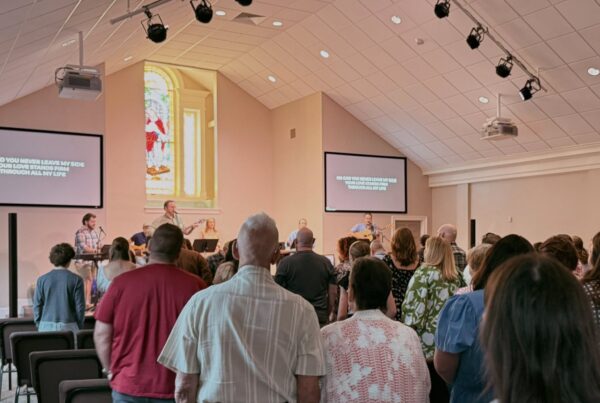I’ve had the pleasure of visiting the historic town of Wittenberg, Germany twice in recent years. From this little town, Martin Luther set the world on fire with his writings, his teaching, and his preaching.
At St. Mary’s Church in Wittenberg, Luther preached from 1514 onward, and at this church today, you can still see several paintings from famous artists during the Reformation. My favorite painting is one depicting Luther preaching. The picture shows Luther with one finger on the text, and one finger pointing to Christ crucified. The congregation’s eyes are all fixed on Christ (not their world-famous preacher!).
The preacher’s goal is to show people the beauty of Jesus, as revealed in Holy Scripture. The rapper Tupac used to sing, “All eyes on me!” but at the heart of Christian preaching is the opposite plea, “All eyes on Jesus.” Faithful pastors long for people to be captivated by Jesus, with them walking away saying, “What a great Savior” and not “What a great sermon.”
Preaching that is God-centered, Christ-exalting, and Spirit-empowered leads to worship and life-transformation. It is to this end that we do the hard and holy work of preparation and delivery. Here are five issues to consider in preaching and worship.
Preaching Corporately
In Nehemiah 8, Ezra receives attention as the leader of a dramatic worship service, but what is also striking is how the phrase “the people” appears thirteen times in the chapter. It’s an inspiring picture of the people of God hearing the voice of God together in public assembly. Another important text that comes to mind is Paul’s charge to Timothy: “Until I come, devote yourself to the public reading of Scripture, to exhortation, to teaching” (1 Tim. 4:13). Paul insists on the reading and expounding of Scripture in corporate worship.
Faithful pastors long for people to be captivated by Jesus, with them walking away saying, “What a great Savior” and not “What a great sermon.”
Preaching can be done in the marketplace and any other space, for we need to be commending the gospel in every nook and cranny of the world. But one of the primary ways we draw people to behold God’s glory in Christ is in the corporate assembly of the church.
Preaching Christocentrically
Beholding the glory of the Lord transforms people (2 Cor. 3:18) because we’re changed from the inside out. Therefore, as preachers, we should purpose to make much of Christ in our sermons so that people may experience such transformation. I remember hearing early in seminary the need to preach “life-changing” sermons. I say “Amen” to that desire, but the question is, how are lives changed? It happens as we gaze upon Christ and the Spirit transforms us.
Paul says “For what we proclaim is not ourselves, but Jesus Christ as Lord, with ourselves as your servants for Jesus’ sake” (2 Cor. 4:5). God has ordained that through the proclamation of Christ, some will have the veil lifted, see Christ’s glory, and be transformed. So, we should thus aim to faithfully proclaim Christ and desperately seek the Spirit’s empowerment to awaken worship and see lives changed.
Preaching Affectionately
As an expositor, I’m attempting to lead the people in worship by showing them Christ’s glory in Holy Scripture. And this should be done from the heart of the preacher who is personally captivated by the beauty of Jesus. In Psalm 45, the Psalmist is preparing to write about the King and the bride (and in my mind a text that points us to Christ’s union with the church), and he says, “My heart overflows with a pleasing theme; I address my verses to the king” (Ps. 45:1). That is the spirit of sermon preparation and delivery: bubbling over with delight in the King.
We commend authentically what we love personally. And when preaching is done from a Christ-adoring heart, it not only magnifies God, it powerfully communicates to the hearts of the hearers. We must avoid being “The Sermonator,” merely going through the motions and mechanically preparing messages. When the Word richly dwells (Col. 3:16) in us, and we know our material well, then we’re ready to let this Word pass from us affectionately.
Preaching Narratively
Sam asks Frodo, “I wonder what sort of a tale we’ve fallen into?” as the two friends journey toward Mordor in Tolkien’s novel, The Two Towers. It’s a relevant question for everyone. The Bible shows us that we have fallen into the best of all stories: the story of redemption. It’s God’s beautiful novel that transforms people, filling them with faith in the Messiah, and giving them a radical new type of hope and joy.
We must avoid being “The Sermonator,” merely going through the motions and mechanically preparing messages. We commend authentically what we love personally.
One of the practical ways we keep Christ central in our proclamation is by setting forth the narrative of Scripture. As we preach from a specific text, bringing its truth in view, we should also set it within the overarching storyline of Scripture. And this story involves looking back and looking forward. Seeing the glory of God within the story of God leads to the worship of God.
Preaching Artistically
To draw people into the exaltation of Christ, preachers must aim to be clear in their communication. And while what we say is more important than how we say it, we should nevertheless consider how we speak. This includes the structure of our message and our use of memorable, striking, and appealing language. While preachers can go overboard into showmanship on the use of rhetoric, we should not dismiss the importance of saying things in a way that arouses interest and stirs affection—much the way songs do.
The biblical writers understood the importance of word choice. For example, in Psalm 2, the writer could simply say, “God is sovereign over the rebellious nations,” but instead, he says, “He who sits in the heavens laughs” (Ps. 2:4). Well-chosen and beautiful language is fitting when communicating Christ’s beauty.
So then, let us keep preaching Christ in the corporate gatherings. Let us keep preaching Christ as a worshiper. And let us seek to awaken worship by exalting Christ, by highlighting the biblical narrative, and by expressing our thoughts as clearly and beautifully as we can, with a finger on the text as we point people to the hero of Scripture, Christ our King.
Editor’s Note: A longer version of this article will appear in the forthcoming revised edition of The Contemporary Handbook on Preaching edited by Michael Duduit.











